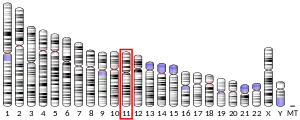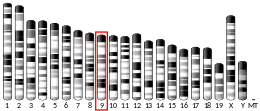多巴胺受體D2
多巴胺受體D2(,簡稱D2R),為轉譯自 DRD2 基因的一種多巴胺受體蛋白。D2R最早於1975年為Philip Seeman所發現,並將其命名為「抗精神疾患性多巴胺受體」(antipsychotic dopamine receptor)[8]。D2R為所有抗精神病药物的作用標的。
功能
D2R屬於一種多巴胺受體,並會與Gi結合。Gi為G蛋白偶联受体的一種亞型,會抑制腺苷酸环化酶的活性[9]。
在小鼠模式中,齒狀回的neuronal calcium sensor-1(NCS-1)會影響D2R在細胞膜的表現量。這項機制會影響突触可塑性及記憶形成[10]。
同型體
长形式(D2Lh)具有"规范"的序列,并作为经典突触后蛋白发挥作用。[13]短形式(D2Sh)在突触前作为调节突触间隙中多巴胺水平的自身受体发挥作用。[13]D2Sh受体激动时抑制多巴胺释放,拮抗时增加多巴胺释放。[13]第三种D2(更长)的形式不同于270V被VVQ取代的规范序列。[14]
基因組
等位基因變異:
- A-241G
- C132T、G423A、T765C、C939T、C957T,以及G1101A[15]
- Cys311Ser
- -141C insertion/deletion[16]The polymorphisms have been investigated with respect to association with schizophrenia.[17]
Some researchers have previously associated the polymorphism Taq 1A (rs1800497) to the DRD2 gene. However, the polymorphism resides in exon 8 of the ANKK1 gene.[18]DRD2 TaqIA polymorphism has been reported to be associated with an increased risk for developing motor fluctuations but not hallucinations in Parkinson's disease.[19][20]
配體
大多数较老的抗精神病药如氯丙嗪或氟哌啶醇是多巴胺D2受体的非选择性拮抗剂,最多仅对"D2样家族"受体具有选择性,因此与D2、D3、D4以及许多其他受体都可以结合,例如血清素和组胺受体,导致一系列副作用使得它们不适合科学研究。类似,用于治疗帕金森病的较旧的多巴胺激动剂例如溴隐亭和卡麦角林,对一种多巴胺受体的选择性较差,尽管这些药物中大多数确实能起到D2激动剂的作用,但它们也会影响其他多巴胺受体,亚型也是。现今有几种选择性D2配体 (生物化学)可以使用,并且随着进一步的研究,这个数字可能会增加。
受體致活劑
- 溴隱亭(Bromocriptine):完全受體致活劑
- Cabergoline(Caberl)
- N,N-Propyldihydrexidine:D1/D5受體制活劑dihydrexidine的類似物,對節後神經元的D2R親和性比節前神經元的D2自體受器高。
- Piribedil:同時也是 D3 受體致活劑及腎上腺素α2受體拮抗劑
- Pramipexole:同時也是D3、D4受體致活劑
- Quinelorane:affinity for D2 > D3
- Quinpirole:同時也是D3受體致活劑
- Ropinirole:完全受體致活劑
- Sumanirole:高選擇性完全受體致活劑
- Talipexole:對D2的親和性高於其他的多巴胺受體,但同時也是腎上腺素α2受體制活劑及5-HT3受體拮抗劑。
部分受體致活劑
- Aplindore
- 阿立哌唑(Aripiprazole,在美國合法)[21]
- Brexpiprazole/OPC-34712
- Cariprazine
- RP5063
- GSK-789,472 – Also D3 antagonist, with good selectivity over other receptors [22]
- 氯胺酮(Ketamine,同時也為NMDA受體拮抗劑)
- LSD – in vitro, LSD was found to be a partial agonist and potentiates dopamine-mediated prolactin secretion in lactotrophs.[23]LSD is also a 5-HT2A agonist.
- 莫达非尼(Modafinil)
- Roxindole (only at the D2 autoreceptors)
- OSU-6162:亦為5-HT2A部分受體致活劑,acts as "dopamine stabilizer"
- Salvinorin A:亦為κ-鴉片類受體致活劑。
受體拮抗劑
- Atypical antipsychotics
- Desmethoxyfallypride
- Domperidone – D2 and D3 antagonist; does not cross the blood-brain barrier
- Eticlopride
- Fallypride
- Hydroxyzine (Vistaril, Atarax)
- Itopride
- L-741,626 – highly selective D2 antagonist
- C11 Raclopride radiolabled – commonly employed in positron emission tomography studies[24]
- Typical antipsychotics
- SV 293[25]
- Yohimbine
- D2sh selective (presynaptic autoreceptors)
Functionally selective ligands
- 參見參考文獻[31]。
Protein–protein interactions
多巴胺受体 D2 已被证明与EPB41L1、[32]PPP1R9B[33] 和 NCS-1 相互作用。[34]
Receptor oligomers
The D2 receptor forms receptor heterodimers in vivo (in living animals) with other G protein-coupled receptors; these include:[35]
- D1–D2 dopamine receptor heteromer
- D2–adenosine A2A
- D2–ghrelin receptor
- D2sh–TAAR1[note 1]
The D2 receptor has been shown to form hetorodimers in vitro (and possibly in vivo) with DRD3,[38]DRD5,[39]and 5-HT2A.[40]
註釋
- D2sh–TAAR1 is a presynaptic heterodimer which involves the relocation of TAAR1 from the intracellular space to D2sh at the plasma membrane, increased D2sh agonist binding affinity, and signal transduction through the calcium–PKC–NFAT pathway and G-protein independent PKB–GSK3 pathway.[36][37]
參考文獻
- .
- .
- .
- GRCh38: Ensembl release 89: ENSG00000149295 - Ensembl, May 2017
- GRCm38: Ensembl release 89: ENSMUSG00000032259 - Ensembl, May 2017
- . National Center for Biotechnology Information, U.S. National Library of Medicine.
- . National Center for Biotechnology Information, U.S. National Library of Medicine.
- Madras BK. . Journal of the History of the Neurosciences. 2013, 22 (1): 62–78. PMID 23323533. doi:10.1080/0964704X.2012.678199.
- Usiello A, Baik JH, Rougé-Pont F, Picetti R, Dierich A, LeMeur M, Piazza PV, Borrelli E. . Nature. Nov 2000, 408 (6809): 199–203. PMID 11089973. doi:10.1038/35041572.
- Saab BJ, Georgiou J, Nath A, Lee FJ, Wang M, Michalon A, Liu F, Mansuy IM, Roder JC. . Neuron. Sep 2009, 63 (5): 643–56. PMID 19755107. doi:10.1016/j.neuron.2009.08.014.
- Wiemerslage L, Schultz BJ, Ganguly A, Lee D. . Journal of Neurochemistry. Aug 2013, 126 (4): 529–40. PMID 23452092. doi:10.1111/jnc.12228.
- . (原始内容存档于2010-03-07).
- Beaulieu JM, Gainetdinov RR. . Pharmacological Reviews. Mar 2011, 63 (1): 182–217. PMID 21303898. doi:10.1124/pr.110.002642.
- UniProt P14416
- Duan J, Wainwright MS, Comeron JM, Saitou N, Sanders AR, Gelernter J, Gejman PV. . Human Molecular Genetics. Feb 2003, 12 (3): 205–16. PMID 12554675. doi:10.1093/hmg/ddg055.
- Arinami T, Gao M, Hamaguchi H, Toru M. . Human Molecular Genetics. Apr 1997, 6 (4): 577–82. PMID 9097961. doi:10.1093/hmg/6.4.577.
- Glatt SJ, Faraone SV, Tsuang MT. . American Journal of Medical Genetics. Part B, Neuropsychiatric Genetics. Jul 2004, 128B (1): 21–3. PMID 15211624. doi:10.1002/ajmg.b.30007.
- Lucht M, Rosskopf D. . Science. Jul 2008, 321 (5886): 200; author reply 200. PMID 18621654. doi:10.1126/science.1155372.
- Wang J, Liu ZL, Chen B. . Neurology. Jun 2001, 56 (12): 1757–9. PMID 11425949. doi:10.1212/WNL.56.12.1757.
- Wang J, Zhao C, Chen B, Liu ZL. . Neuroscience Letters. Jan 2004, 355 (3): 193–6. PMID 14732464. doi:10.1016/j.neulet.2003.11.006.
- . RxList.com. 2010-01-21 [2010-01-21]. (原始内容存档于2010-01-18).
- Holmes IP, Blunt RJ, Lorthioir OE, Blowers SM, Gribble A, Payne AH, Stansfield IG, Wood M, Woollard PM, Reavill C, Howes CM, Micheli F, Di Fabio R, Donati D, Terreni S, Hamprecht D, Arista L, Worby A, Watson SP. . Bioorganic & Medicinal Chemistry Letters. Mar 2010, 20 (6): 2013–6. PMID 20153647. doi:10.1016/j.bmcl.2010.01.090.
- Giacomelli S, Palmery M, Romanelli L, Cheng CY, Silvestrini B. . Life Sciences. 1998, 63 (3): 215–22. PMID 9698051. doi:10.1016/S0024-3205(98)00262-8.
- Wang GJ, Volkow ND, Thanos PK, Fowler JS. . Journal of Addictive Diseases. 2004, 23 (3): 39–53. PMID 15256343. doi:10.1300/J069v23n03_04.
- Huang R, Griffin SA, Taylor M, Vangveravong S, Mach RH, Dillon GH, Luedtke RR. . Pharmacology. 2013, 92 (1–2): 84–9. PMID 23942137. doi:10.1159/000351971.
- Agnati LF, Ferré S, Genedani S, Leo G, Guidolin D, Filaferro M, Carriba P, Casadó V, Lluis C, Franco R, Woods AS, Fuxe K. . Journal of Proteome Research. Nov 2006, 5 (11): 3077–83. PMID 17081059. doi:10.1021/pr0601382.
- Beyaert MG, Daya RP, Dyck BA, Johnson RL, Mishra RK. . European Neuropsychopharmacology. Mar 2013, 23 (3): 253–62. PMID 22658400. doi:10.1016/j.euroneuro.2012.04.010.
- Lane JR, Donthamsetti P, Shonberg J, Draper-Joyce CJ, Dentry S, Michino M, Shi L, López L, Scammells PJ, Capuano B, Sexton PM, Javitch JA, Christopoulos A. . Nature Chemical Biology. Sep 2014, 10 (9): 745–52. PMID 25108820. doi:10.1038/nchembio.1593.
- Maggio R, Scarselli M, Capannolo M, Millan MJ. . European Neuropsychopharmacology. Sep 2015, 25 (9): 1470–9. PMID 25453482. doi:10.1016/j.euroneuro.2014.09.016.
- Silvano E, Millan MJ, Mannoury la Cour C, Han Y, Duan L, Griffin SA, Luedtke RR, Aloisi G, Rossi M, Zazzeroni F, Javitch JA, Maggio R. . Molecular Pharmacology. Nov 2010, 78 (5): 925–34. PMC 2981362
 . PMID 20702763. doi:10.1124/mol.110.065755.
. PMID 20702763. doi:10.1124/mol.110.065755. - Möller D, Kling RC, Skultety M, Leuner K, Hübner H, Gmeiner P. . Journal of Medicinal Chemistry. Jun 2014, 57 (11): 4861–75. PMID 24831693. doi:10.1021/jm5004039.
- Binda AV, Kabbani N, Lin R, Levenson R. . Molecular Pharmacology. Sep 2002, 62 (3): 507–13. PMID 12181426. doi:10.1124/mol.62.3.507.
- Smith FD, Oxford GS, Milgram SL. . The Journal of Biological Chemistry. Jul 1999, 274 (28): 19894–900. PMID 10391935. doi:10.1074/jbc.274.28.19894.
- Kabbani N, Negyessy L, Lin R, Goldman-Rakic P, Levenson R. . The Journal of Neuroscience. Oct 2002, 22 (19): 8476–86. PMID 12351722.
- Beaulieu JM, Espinoza S, Gainetdinov RR. . British Journal of Pharmacology. Jan 2015, 172 (1): 1–23. PMC 4280963
 . PMID 25671228. doi:10.1111/bph.12906.
. PMID 25671228. doi:10.1111/bph.12906. - Grandy DK, Miller GM, Li JX. . Drug Alcohol Depend. February 2016, 159: 9–16. PMID 26644139. doi:10.1016/j.drugalcdep.2015.11.014.
This original observation of TAAR1 and DA D2R interaction has subsequently been confirmed and expanded upon with observations that both receptors can heterodimerize with each other under certain conditions ... Additional DA D2R/TAAR1 interactions with functional consequences are revealed by the results of experiments demonstrating that in addition to the cAMP/PKA pathway (Panas et al., 2012) stimulation of TAAR1-mediated signaling is linked to activation of the Ca++/PKC/NFAT pathway (Panas et al.,2012) and the DA D2R-coupled, G protein-independent AKT/GSK3 signaling pathway (Espinoza et al., 2015; Harmeier et al., 2015), such that concurrent TAAR1 and DA DR2R activation could result in diminished signaling in one pathway (e.g. cAMP/PKA) but retention of signaling through another (e.g., Ca++/PKC/NFA)
- Harmeier A, Obermueller S, Meyer CA, Revel FG, Buchy D, Chaboz S, Dernick G, Wettstein JG, Iglesias A, Rolink A, Bettler B, Hoener MC. . Eur Neuropsychopharmacol. 2015, 25 (11): 2049–61. PMID 26372541. doi:10.1016/j.euroneuro.2015.08.011.
Interaction of TAAR1 with D2R altered the subcellular localization of TAAR1 and increased D2R agonist binding affinity.
- Maggio R, Millan MJ. . Current Opinion in Pharmacology. Feb 2010, 10 (1): 100–7. PMID 19896900. doi:10.1016/j.coph.2009.10.001.
- Hasbi A, O'Dowd BF, George SR. . Current Opinion in Pharmacology. Feb 2010, 10 (1): 93–9. PMC 2818238
 . PMID 19897420. doi:10.1016/j.coph.2009.09.011.
. PMID 19897420. doi:10.1016/j.coph.2009.09.011. - Albizu L, Holloway T, González-Maeso J, Sealfon SC. . Neuropharmacology. Sep 2011, 61 (4): 770–7. PMC 3556730
 . PMID 21645528. doi:10.1016/j.neuropharm.2011.05.023.
. PMID 21645528. doi:10.1016/j.neuropharm.2011.05.023.
外部連結
- 醫學主題詞表(MeSH):Receptors,+Dopamine+D2
- Pappas, Stephanie. . Imaginova Corp. LiveScience. [20 January 2011].
多巴胺受體D2引用了美国国家医学图书馆提供的資料,这些資料属于公共领域。
Template:Dopaminergics







